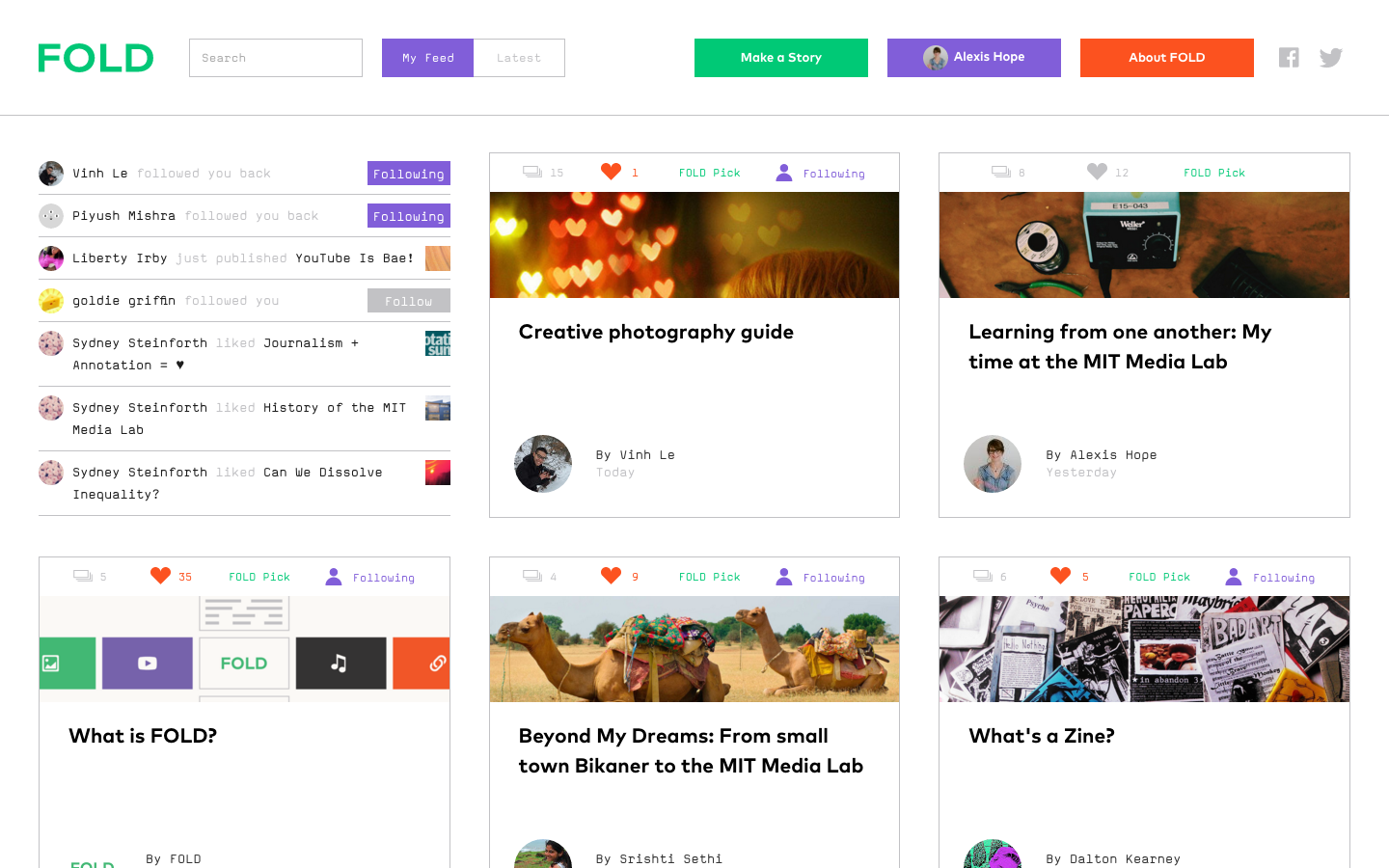Bringing Joy to Technology Design
Published by: WCET | 3/31/2016
Tags: Course Design, Digital Learning, Instructional Design, Teaching
Published by: WCET | 3/31/2016
Tags: Course Design, Digital Learning, Instructional Design, Teaching
We welcome Alexis Hope, MIT Media Lab, as today’s guest blogger, as she gives us a peek at a new publishing platform that incorporates many types of multimedia into your text copy. Alexis and a panel of MIT Media Lab students will be speaking at the WCET Annual Meeting, Oct. 12-14 in Minneapolis. Join us to hear more about innovation, cultivating entrepreneurial spirit, and design. — Megan Raymond and Russ Poulin, WCET
For the past year, I’ve been developing an open-source multimedia publishing platform called FOLD. FOLD grew out of my thesis work at the MIT Media Lab, where I worked in the Center for Civic Media led by Ethan Zuckerman. The platform was originally created to help journalists supplement news with context to support novice news readers, but we opened it up to the public when we launched. Now, alongside use by journalists and independent writers, FOLD has begun to see wide use in the classroom by teachers looking to help students build media literacy and learn how to write for public audiences.

Being “Playful” with Design
In our research, we’re investigating how being playful with design can give students the space and freedom to find their unique voice and writing style. We’ve found that students of all ages are motivated by being able to incorporate the kinds of media they interact with on a daily basis into an assignment, and older students in particular are proud of a polished and professional final product that helps elevate their work.
On FOLD, stories are composed of text and media cards. Text cards form the backbone of the story, and media cards branch out to the side of each text card. Writers can annotate their text with these media cards to create an interactive story. Media cards can be created by searching through user-generated content sites like YouTube, Flickr, Soundcloud, and more from inside the text editor. Blending research tools with a writing environment, FOLD allows writers to easily find source material and references to support their words.
It’s been a joy to see the creativity and expressiveness of student writers; FOLD has been used to create how-to’s, science explainers, photo essays, project portfolios, and history reports, but outside of formal assignments, students are creating fiction and poetry, game tutorials, movie reviews, and more experimental pieces. Giving students opportunities to connect learning goals with outside interests can be incredibly rewarding and gives them the chance to create a portfolio piece of which they can be proud.


Prior to joining the MIT Media Lab, I worked to re-design extremely complicated medical device interfaces. I’m motivated by design challenges that center on making complex systems understandable and accessible to wide audiences. I’m also inspired by playfulness, and believe that when possible, our interfaces should add some fun to our day. In an educational context, infusing technology with joy is especially important when so many other technologies are competing for students’ attention.
I love creating moments of joy for the people who interact with what could otherwise be just another boring tool. FOLD’s moments of joy are created by bright colors, playful language, bold iconography, and support for a wide variety of multimedia. We’ve also incorporated the ability to find and “follow” other authors on the platform, an aspect of social networking platforms with which many students are familiar.
FOLD Helps Connect the Fragments of Information Across Media
Visual design is important, but thoughtful design goes beyond the surface. I’m fascinated by the way that the Web has transformed how people think, write, and learn. There are many writing tools available to students, but few that speak to the changing nature of how we learn and how we interact with information. Increasingly, we experience content in discrete fragments—a YouTube tutorial, a photo of a protest, a humorous Tweet, or a link to the viral article everyone in our Facebook circle is talking about. But sometimes it feels like all of this information doesn’t really amount to much. On FOLD, students are able to bring together the fragments of the Web into a cohesive whole, so they can turn that one YouTube video into something much more substantial.
As technology users we have come to expect beautiful and thoughtful design in many of the products we use every day, and educational technology should be no different. I’m inspired by many other technologies I see being developed with joy and play in mind, such as:
When design and engineering sit side-by-side and are attentive to the needs of the people at the center of complex systems, our technologies can be beautiful, fun, and useful in equal measures.
If you’d like to try FOLD with your students, or just want to chat about design and technology, feel free to e-mail me at alexis@fold.cm. You can also find me on Twitter— I’m @alexishope.
Alexis Hope
Creative Director at FOLD
alexis@fold.cm
1 reply on “Bringing Joy to Technology Design”
[…] with several leaders from innovation hubs from institutions across the United States, including an MIT media lab student who has launched her own open source content platform, FOLD , in Innovation Hubs and Labs: Driving Change and […]